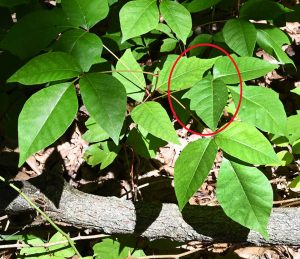The Itch
A guide to avoiding poison ivy —and advice if you haven’t.


Anticipating that many of our readers will soon be increasing their time preparing their gardens and yards for outdoor enjoyment, it seems fitting that we discuss a common annoyance—poison ivy, oak and sumac. The U.S. Food and Drug Administration tells us that 90 percent of Americans are allergic to urushiol, the oil that causes the itchy rash for which these plants are known.
Each of these plants contains this oil, which is within the plant and not necessarily on the surface unless the plant is damaged. But when we trod on it, rub it, or pull it out—or a person or animal has bruised it before contact—we are then subject to exposure.
My husband would always suggest he had gotten the rash from our dogs. I was skeptical about his theory only to discover he is correct; it can be on your pet’s fur. In fact clothing, shoe laces, jewelry, shoes, etc. commonly remain contaminated for one to five years after coming in contact with urushiol. You can also get it from garden implements that you have used to remove it. One billionth of a gram can cause a rash. In fact, century-old specimens of plants can cause dermatitis in highly sensitive people. Yes, dead plants can transmit the oil.
So now, after spending a lifetime trying to get my fellow humans into the wild, I just drove you back inside. What gives? Well, all is not lost; there are a number of things you can do to help protect yourself from urushiol, and identification is at the top of the list. And since in southern New Jersey poison ivy is the most likely culprit, identification and avoidance of this plant can go a long way toward keeping you itch-free.
Adages are all the rage on our children’s walks. Commonly our naturalists relay characteristics of poison ivy with rhymes: “Leaves of three, let it be,” and “Hairy vine, no friend of mine.” As the first expression suggests, three glossy leaflets deriving from one stem are a major clue. But honestly, poison ivy has rather variable leaves that are generally smooth-edged, but toothed or jagged margins also occur. In the fall the color may be yellow, orange, or red; additionally it gets tiny greenish flowers and has green or off-white berries.
Sometimes it is tiny like a new shrub, and other times it is so vigorous that it appears to be the branches of the host tree itself. Thick hairy vines can climb up a tall tree trunk before spreading out. I’ve seen vines as big around as a good-sized fist.
There are lots of precautions you can take if you think you’ve been exposed to urushiol while on a hike or working in your yard. Your first assignment is go directly to a sink and wash your hands. I prefer to use New Dawn dish detergent or Fels-Naptha soap for this purpose. Remember, anything you touch can become exposed to the oils. Experts recommend wiping your hands or any infected area with a cloth and rubbing alcohol. A number of my friends recommend products like Tecnu, designed to remove the oils. Remove your clothes and put them directly in the washer. Then scrub your hands again, plus any other exposed areas of your body. Wash your clothes in soapy water. I suggest you launder them separately from other articles to prevent cross-contamination.
Next, take a shower and soap up very well, rinse, and repeat. You can choose to apply alcohol or Tecnu but do not get either in your eyes or on other sensitive areas. I simply use Fels or New Dawn.
Fels-Naptha can be found as a soap bar in the laundry detergent section of the supermarket; it contains lye that is great for getting the oils off your skin. And by the way it is also great for removing stains from clothing. Once gardening begins I keep a bar by the hose outside and wash my hands with it before coming into the house, especially if I think I’ve been exposed. Sometimes after a canoe trip we pass a Fels-Naptha bar around so folks can wash their hands and arms as a precaution.
Unfortunately, it takes urushiol a very short time to penetrate the skin. If you wash before 10 minutes of exposure you may not get a rash. Your main purpose in washing is to prevent further spreading, and remember also to scrub under your fingernails. If you use alcohol it is advised that you not return to a poison ivy area the same day because you have removed your skin’s own protective oils.
If you have never been exposed before, the rash might not appear for a week to 10 days. People who are already sensitized usually have a reaction of swelling, redness, and itching in 12 to 48 hours. Blisters will often follow; these look a bit like chickenpox. One statistic I came across said 500 people could itch from the amount covering the head of a pin. I don’t really care about the other 499, who never touched the pin to begin with, but this statistic does underscore the plant’s potency.
Prevention is a lot better than dealing with the rash. Wear long sleeves when working in the yard. Some highly allergic people wear plastic gloves inside their garden gloves. If you are actually going to consider pulling poison ivy I strongly suggest this. However, if poison ivy is in a high traffic area I recommend that a herbicide like glyphosate be applied. You can keep a spray bottle in a safe place for this purpose.
Whatever you do, don’t burn any part of the plant! The oil becomes volatilized in the smoke, travels, and can expose people’s lungs to the oils, causing a serious or possibly deadly reaction.
One of my friends pulls ivy because he is not allergic. And he even eats it! In my opinion this is mighty foolhardy. In fact, the more times you are exposed to urushiol the more likely you are to break out in a reaction. And remember, the first time you have a reaction it usually doesn’t appear for a week or 10 days. As a child I did not get poison ivy, but after pulling it by error in the garden I’ve had blisters on my hands as an adult. Fortunately, I’ve had the good fortune not to have it spread by addressing it promptly with washing. (I hope I don’t have to eat those words!)
What to do if you have the evil rash? Don’t scratch, as hard as that may be; just don’t! If you suspect you are scratching in your sleep wear cotton gloves like the ones they put on infants to prevent your nails from causing infection. And if it is on your eyes or in your pelvic region, scientifically referred to as “your hoo-ha” at our house—call a doctor. Occasionally people need a prescription for topical corticosteroid drugs that can halt the reaction.
Hydrocortisone creams are recommended for the itch. There are lots of over-the-counter preparations to address the irritation or dry up the oozing blisters. Lotions with calamine, zinc acetate, and alcohol can dry blisters and hasten healing. Products are numerous. Tecnu makes a cream for the rash, and there’s also Domeboro, Aveno oatmeal bath, and many products containing aluminum hydroxide, calamine, kaolin, aluminum, or zinc acetate and zinc oxide. A pharmacist can guide you in the proper direction.
There are some falsely held beliefs that I will attempt to dispel. Poison ivy is not contagious. However, you can get it from clothing or implements, used by someone else, that have not been cleaned. Poison ivy does not spread; the oils can but that is why you wash. In actuality what happens is people scratch. This can cause infection, which could spread. Also, if you scratch when the oil is still on your body you will spread it, but it does not spread from the blisters.
So why not just bomb all the poison ivy with glyphosate to begin with? First of all glyphosate is a suspected carcinogen. Furthermore, the reason why we see poison ivy in so many areas is because birds eat the fruit and broadcast the seeds in their droppings, which makes it hard to eradicate. Many animals—deer, bear, and raccoons—eat the leaves, stems, and fruit without ill effects. In fact, humans and a few primates are the only animals that get a rash from poison ivy. To avoid it, just watch what you touch and learn to identify it. Poison ivy is beneficial and part of our ecosystem, so it’s best to live with it but not in it!
Happy wandering!
Sources:
• Poison Ivy Information Center
• U.S. Food and Drug Administration
• Mayo Clinic
• Missouri Department of Conservation
•Smithsonian, “A Poison Ivy Primer”








